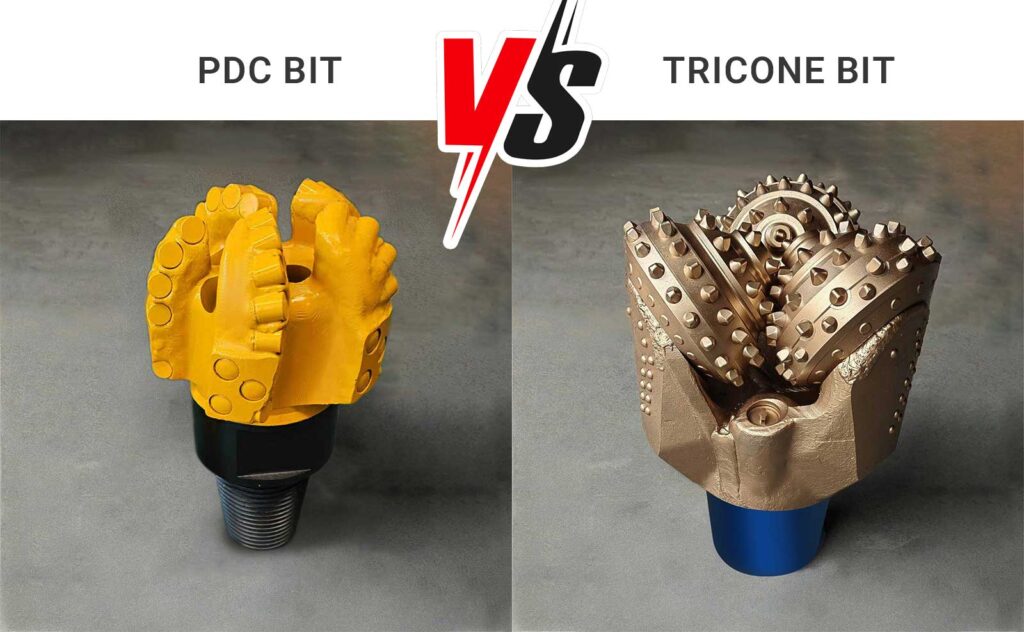Many people wonder which is better between a PDC drill and a tri-cone drill. Since drilling conditions vary, depending on the actual needs at the time of drilling, perhaps drilling at a higher speed (drilling rate) is preferred, or perhaps drilling distance is valued more than drilling speed, it is important to first analyze and make a judgment on these conditions and expectations.

What Is a Diamond PDC Drill Bit?
PDC drill bits (polycrystalline diamond compact bits) use synthetic diamond cutters bonded to the bit surface. They shear through rock by continuous scraping rather than crushing, which makes drilling faster and smoother compared to traditional bits.
What is a Tricone Drill Bit?
Tricone bits use three rotating cones with steel or tungsten carbide teeth to crush rock. While reliable in many formations, they often wear out faster, require frequent replacement, and deliver slower penetration rates in hard rock.
What Challenges Do Tricone Bits Face in Drilling?
Tricone bits often generate vibrations and inconsistent penetration in hard or abrasive formations. This can reduce drilling accuracy and increase the risk of wellbore instability, leading to higher operational challenges.
How PDC Drill Bits Improve Drilling Stability
With their fixed cutter design, PDC bits deliver smoother and more stable drilling performance. Reduced vibration ensures a straighter wellbore, minimizes deviation, and improves overall drilling quality.
Energy Efficiency: Lower Torque and Power Consumption
Compared to tricone bits, PDC drill bits require less torque to maintain high penetration rates. This lowers energy consumption, reduces stress on drilling equipment, and improves rig efficiency.
Reduced Maintenance and Fewer Bit Trips
Tricone bits often need frequent replacement due to worn cones or broken teeth. PDC bits, with their diamond cutters, stay sharp longer and reduce the number of bit trips, saving time and lowering maintenance costs.
Better Performance in Directional Drilling
Tricone bits can struggle with directional control, especially in complex boreholes. PDC drill bits provide better steerability, making them ideal for modern applications like HDD, foundation drilling, and geothermal projects.
Tricone Bit Components
A tricone bit is assembled from multiple components, including the bit arms, three different cones, locking balls, bearing seal O-rings, grease, tungsten carbide inserts on both the cones and arms, and grease reservoirs. Any design modification requires new molds for several parts, which is costly and time-consuming. At the same time, workshops must also design custom fixtures to hold different steel components during machining. For example, in the case of 8 1/2″ IADC517 and IADC537, although both bits share the same size, the differences in arm structure mean that the fixtures for machining each arm must be produced separately and cannot be shared. This significantly increases manufacturing complexity and production costs.
PDC Bit Components
PDC drill bits are mainly composed of a steel or matrix body and diamond cutters. Today, steel body PDC bits are more widely used due to their durability and easy manufacturing. Unlike tricone bits, PDC steel bodies do not require new molds or special fixtures for machining, which reduces production costs and lead time. In addition, PDC cutters come in standardized sizes—most commonly 13mm, 16mm, and 19mm—so customization is rarely necessary. This makes PDC bits easier to design, faster to produce, and more cost-efficient for modern drilling applications.
In summary, PDC drill bits are much easier to optimize and improve compared to tricone bits. Engineers can analyze worn PDC bits after drilling, redesign new structures, produce and test them again, and keep refining until the best solution is achieved for a specific formation or driller’s requirement. This cycle of continuous improvement is fast and cost-effective, allowing PDC bits to deliver better performance, longer lifespan, and higher efficiency in modern drilling projects.
